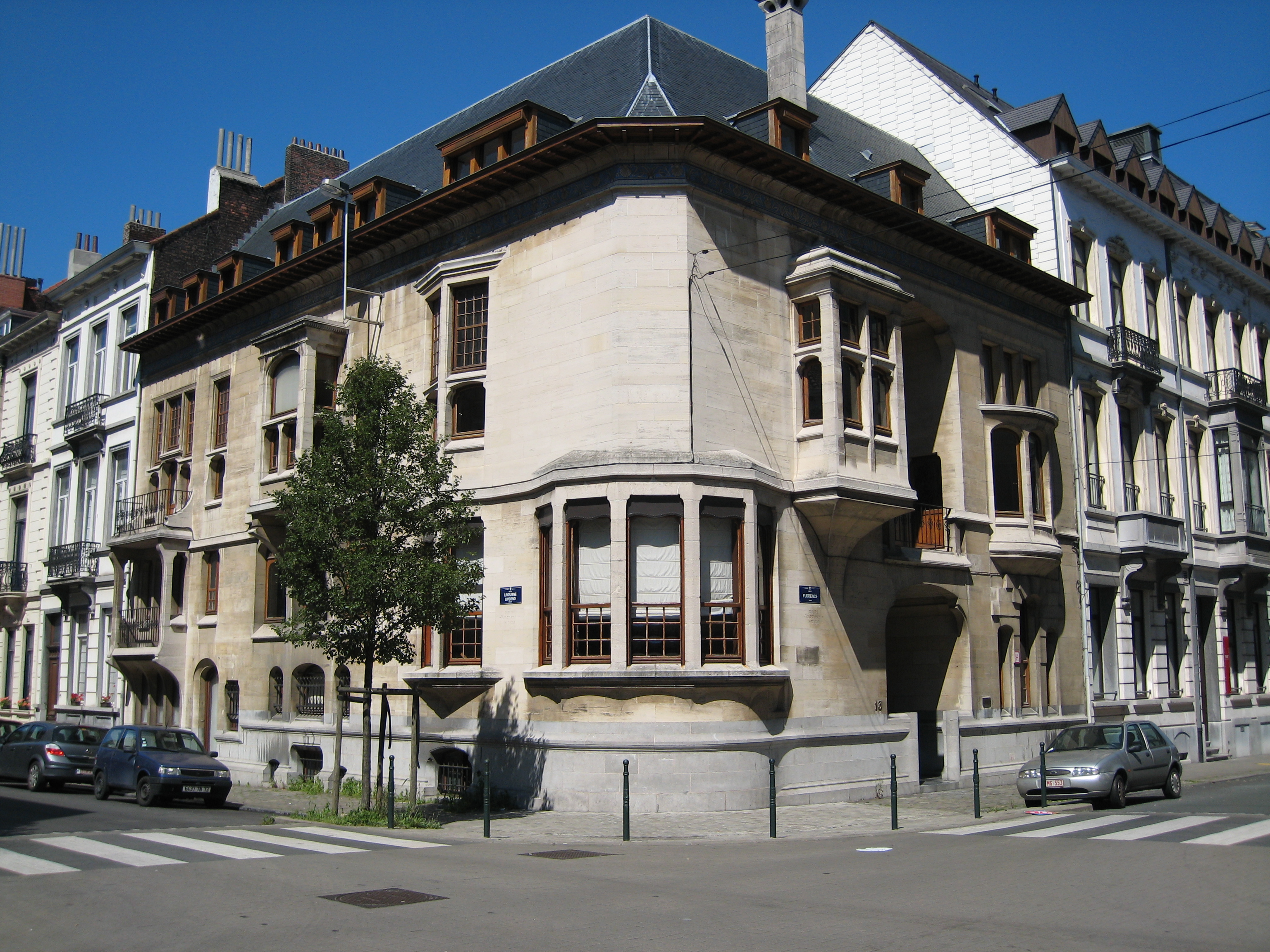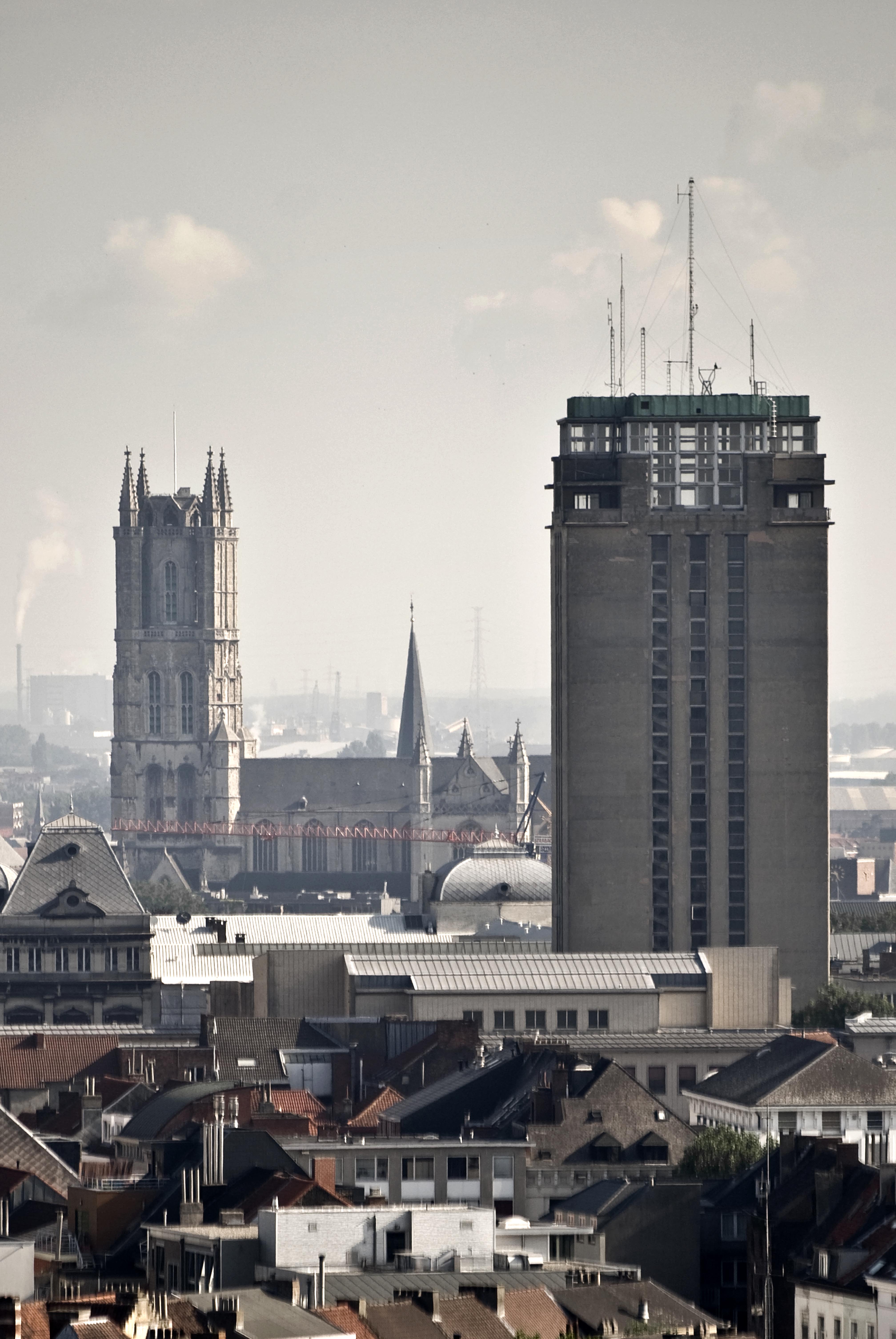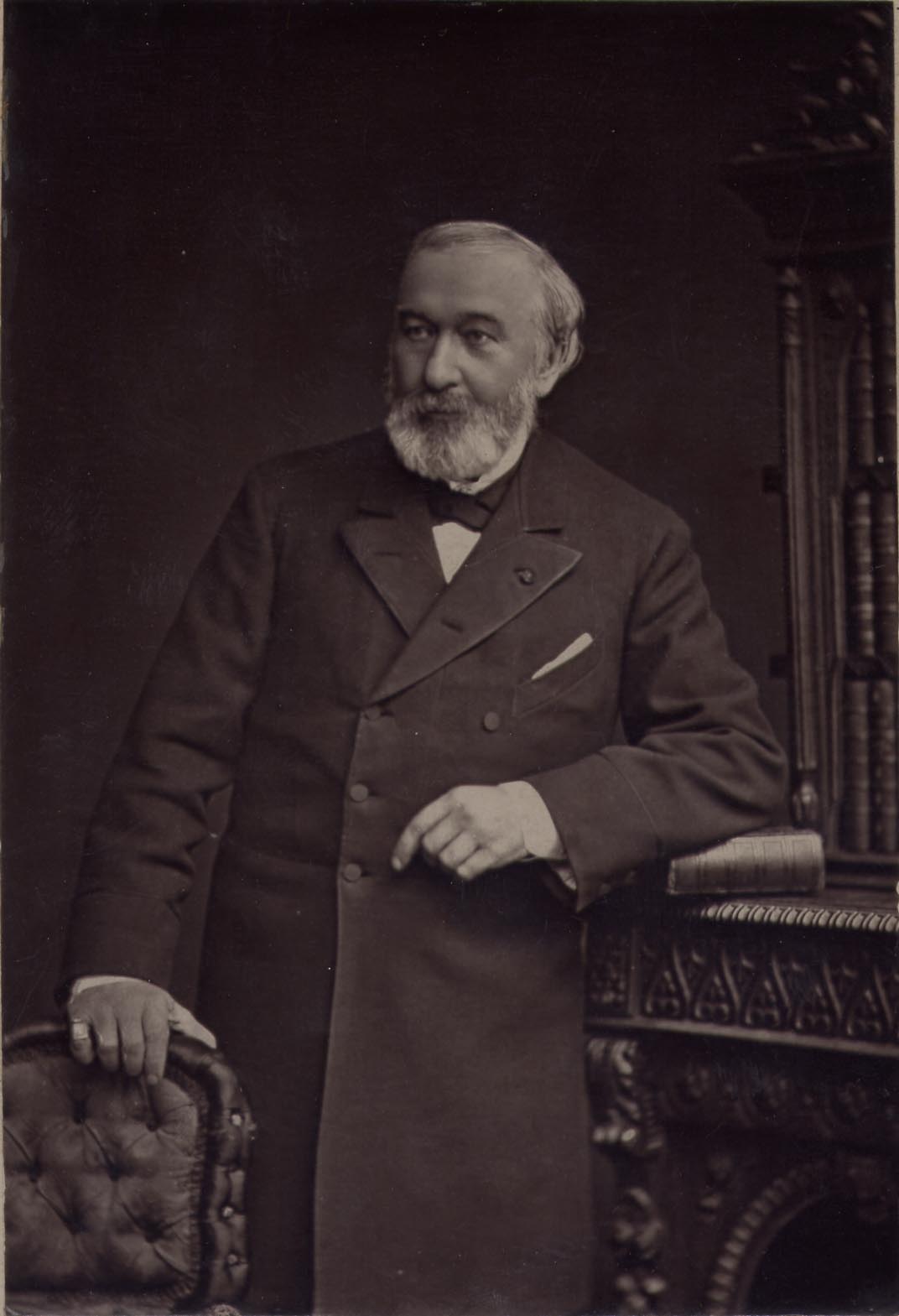|
Octave Van Rysselberghe
Octave van Rysselberghe (22 July 1855 – 30 March 1929) was a Belgian architect of the Art Nouveau period. He is one of the representatives of the architectural renewal that characterized the end of the 19th century, with Victor Horta, Paul Hankar and Henry Van de Velde. Biography Octavius Josephus van Rysselberghe was born in Minderhout, near Antwerp, on 22 July 1855. He was the older brother of the neo-impressionist painter Théo van Rysselberghe (1862–1926) and the younger brother of fellow architect Charles van Rysselberghe and scientist François van Rysselberghe, pioneer of meteorology and long-distance telephony. He studied at the Royal Academy of Fine Arts in Ghent and was trained by Adolphe Pauli in the neoclassical tradition, inspired by the Italian Renaissance. In 1875, together with Ernest Allard, he won second prize in the competition of the Prix de Rome for architecture. At the next edition for architecture, in 1879, he again took second prize, together with Eu ... [...More Info...] [...Related Items...] OR: [Wikipedia] [Google] [Baidu] |
Théo Van Rysselberghe
Théophile "Théo" van Rysselberghe (23 November 1862 – 13 December 1926) was a Belgian neo-impressionist painter, who played a pivotal role in the European art scene at the turn of the twentieth century. Biography Early years Born in Ghent to a French-speaking bourgeois family, he studied first at the Academy of Ghent under Theo Canneel and from 1879 at the Académie Royale des Beaux-Arts in Brussels under the directorship of Jean-François Portaels. The North African paintings of Portaels had started an orientalist fashion in Belgium. Their impact would strongly influence the young Théo van Rysselberghe. Between 1882 and 1888 he made three trips to Morocco, staying there in total a year and a half. Age only eighteen, he had already participated at the Salon of Ghent, showing two portraits. Soon afterwards followed his ''Self-portrait with pipe'' (1880), painted in somber colours in the Belgian realistic tradition of the times. His ''Child in an open spot of the for ... [...More Info...] [...Related Items...] OR: [Wikipedia] [Google] [Baidu] |
Henry Van De Velde
Henry Clemens van de Velde (; 3 April 1863 – 15 October 1957) was a Belgian painter, architect, interior designer, and art theorist. Together with Victor Horta and Paul Hankar, he is considered one of the founders of Art Nouveau in Belgium.'''' He worked in Paris with Samuel Bing, the founder of the first gallery of Art Nouveau in Paris. Van de Velde spent the most important part of his career in Germany and became a major figure in the German Jugendstil. He had a decisive influence on German architecture and design at the beginning of the 20th century. Early life Van de Velde was born in Antwerp, where he studied painting under Charles Verlat at the famous Royal Academy of Fine Arts, Antwerp. He then went on to study with the painter Carolus-Duran in Paris. As a young painter he was strongly influenced by Paul Signac and Georges Seurat and soon adopted a neo-impressionist style, and pointillism. In 1889 he became a member of the Brussels-based artist group "Les XX". After ... [...More Info...] [...Related Items...] OR: [Wikipedia] [Google] [Baidu] |
Uccle
Uccle () or Ukkel () is one of the 19 municipalities of the Brussels-Capital Region, Belgium. In common with all of Brussels' municipalities, it is legally bilingual (French–Dutch). It is generally considered an affluent area of the city and is particularly noted for its community of French immigrants. History According to legend, Uccle's church of St. Peter was dedicated by Pope Leo III in the year 803, with Charlemagne and Gerbald, Bishop of Liège, attending the ceremony. During the following centuries, several noble families built their manors and took residency there. The first mention of the name ''Woluesdal'', now evolved into ''Wolvendael'', dates from 1209. In 1467, Isabella of Portugal, wife of Philip the Good, Duke of Burgundy, founded a Franciscan convent on Uccle's territory. Later, Uccle became the judiciary capital of the area including Brussels. Throughout the early stages of its history, however, the village of Uccle always had a predominantly rural chara ... [...More Info...] [...Related Items...] OR: [Wikipedia] [Google] [Baidu] |
Royal Observatory Of Belgium
The Royal Observatory of Belgium (french: link=no, Observatoire Royal de Belgique, nl, Koninklijke Sterrenwacht van België), has been situated in the Uccle municipality of Brussels (Belgium) since 1890. It was first established in Saint-Josse-ten-Noode in 1826 by William I under the impulse of Adolphe Quetelet. It was home to a diameter aperture Zeiss reflector in the first half of the 20th century, one of the largest telescopes in the world at the time. It owns a variety of other astronomical instruments, such as astrographs, as well as a range of seismograph equipment (for detecting earthquakes). Its main activities are: * Reference systems and geodynamics; * Astrometry and dynamics of celestial bodies; * Astrophysics; * Solar physics. The asteroid 1276 Ucclia is named in honour of the city and the observatory and 16908 Groeselenberg is named for the hill the observatory is located on. History 19th century Adolphe Quetelet first petitioned the government of the Unit ... [...More Info...] [...Related Items...] OR: [Wikipedia] [Google] [Baidu] |
Goblet D'Alviella Family
The Goblet d'Alviella family is an old family from Tournai and originally from the high Portuguese nobility dating back to 1668, it has been recognised in the Belgian nobility. On June 21, 1838, it received from Queen Mary II of Portugal, the hereditary title of "Count of Alviella" and "Grandesse" (see Grandesse of Spain) in favor of Albert Goblet. On November 20, 1838, King Leopold I of Belgium homologated the letters patent and authorized the family to hold this same title in Belgium. On February 22, 1845, Count Louis Goblet d'Alviella and his descendants were allowed to wear a crown of Marquis on their coats of arms instead of a crown of count, by King Leopold I of Belgium. Members * Count Albert Joseph Goblet d'Alviella (1790-1873), officer * Eugène, Count Goblet d'Alviella (10 August 1846 – 9 September 1925) was a lawyer, liberal senator of Belgium and a Professor of the history of religions and rector of the Université libre de Bruxelles. He was the father of Félix. * ... [...More Info...] [...Related Items...] OR: [Wikipedia] [Google] [Baidu] |
Palais De Justice, Brussels
The Palace of Justice of Brussels (french: Palais de Justice de Bruxelles, ; Dutch: ) or Law Courts of Brussels, nl, Rechtbank van Brussel is a courthouse in Brussels, Belgium. It is the country's most important court building, seat of the judicial ''arrondissement'' of Brussels, as well as of several courts and tribunals, including the Court of Cassation (Belgian supreme court), the Court of Assizes (highest criminal court), the Court of Appeal of Brussels (appellate court), the Tribunal of First Instance of Brussels (general jurisdiction), and the Bar Association of Brussels. Designed by the architect Joseph Poelaert, in an eclectic style of Greco-Roman inspiration, to replace an older courthouse, the current building was erected between 1866 and 1883. With a ground surface of , the edifice is reputed to be the largest constructed in the 19th century and remains one of the largest of its kind. The total cost of the construction, land, and furnishings was somewhere in t ... [...More Info...] [...Related Items...] OR: [Wikipedia] [Google] [Baidu] |
Joseph Poelaert
Joseph Poelaert (21 March 1817 – 3 November 1879) was a Belgian architect. He was entrusted with important projects in Brussels, such as Saint Catherine's Church, the Church of Our Lady of Laeken, the Congress Column, the Royal Theatre of la Monnaie and above all, the Palace of Justice. He was also the great-uncle of the architect Henri Van Dievoet. Life Early life Joseph Poelaert was born in Brussels on 21 March 1817. His father was Philip Poelaert (1790–1875), a former architecture student at the Royal Academy of Fine Arts in Brussels. The young Poelaert also trained there under Tilman-François Suys, and then in Paris under Louis Visconti and Jean-Nicolas Huyot. He first came to attention with his winning competition entry for the Congress Column in 1849. He was made city architect of Brussels in 1856. Palace of Justice Poelaert's most significant commission was the colossal Palace of Justice of Brussels, the largest single building constructed in the 19th century ... [...More Info...] [...Related Items...] OR: [Wikipedia] [Google] [Baidu] |
Prix De Rome (Belgium)
The Belgian Prix de Rome ( nl, Prijs van Rome) is an award for young artists, created in 1832, following the example of the original French Prix de Rome. The Royal Academy of Fine Arts Antwerp organised the prize until 1920, when the national government took over. The first prize is also sometimes called the Grand Prix de Rome. There were distinct categories for painting, sculpture, architecture and music. History The Prix de Rome was a scholarship for arts students. It was created in 1663 in France under the reign of Louis XIV. It was an annual burse for promising artists (painters, sculptors, and architects) who proved their talents by completing a very difficult elimination contest. The prize, organised by the Royal Academy of Painting and Sculpture (''Académie royale de peinture et de sculpture''), was open to their students. The award winner would win a stay at the Palazzo Mancini in Rome at the expense of the King of France. The stay could be extended if the director of ... [...More Info...] [...Related Items...] OR: [Wikipedia] [Google] [Baidu] |
Ernest Allard
Ernest (e) Allard (1820–1900) was a French entomologist who specialised in Coleoptera. He is not to be confused with the Belgian entomologist Vincent Allard (1921–1994). Allard's collection was acquired by René Oberthür and is now held by Muséum national d'histoire naturelle, in Paris and Museum Koenig in Bonn. He was a Member of the Société entomologique de France The Société entomologique de France, or French Entomological Society, is devoted to the study of insects. The society was founded in 1832 in Paris, France. The society was created by eighteen Parisian entomologists on January 31, 1832. The first .... Works *Allard, E. 1869. Révision du genre Asida Latreille. ''L'Abeille'', ''Revue d'Entomologie'' 6: 159–305. *Allard, E. 1876. Révision des hélopines vrais de Lacordaire, ''L'Abeille'', R''evue d'Entomologie'' 14: 1–80. Further reading *Aubé C. 1863. ew taxa In: Grenier A. J. F.: ''Catalogue des coléoptères de France et matériaux pour servir ... [...More Info...] [...Related Items...] OR: [Wikipedia] [Google] [Baidu] |
Ghent
Ghent ( nl, Gent ; french: Gand ; traditional English: Gaunt) is a city and a municipality in the Flemish Region of Belgium. It is the capital and largest city of the East Flanders province, and the third largest in the country, exceeded in size only by Brussels and Antwerp. It is a port and university city. The city originally started as a settlement at the confluence of the Rivers Scheldt and Leie and in the Late Middle Ages became one of the largest and richest cities of northern Europe, with some 50,000 people in 1300. The municipality comprises the city of Ghent proper and the surrounding suburbs of Afsnee, Desteldonk, Drongen, Gentbrugge, Ledeberg, Mariakerke, Mendonk, Oostakker, Sint-Amandsberg, Sint-Denijs-Westrem, Sint-Kruis-Winkel, Wondelgem and Zwijnaarde. With 262,219 inhabitants at the beginning of 2019, Ghent is Belgium's second largest municipality by number of inhabitants. The metropolitan area, including the outer commuter zone, covers an area of and had ... [...More Info...] [...Related Items...] OR: [Wikipedia] [Google] [Baidu] |
Royal Academy Of Fine Arts (Ghent)
The Royal Academy of Fine Arts of Ghent ( nl, Koninklijke Academie voor Schone Kunsten van Gent, KASK) is an art school that is one of the oldest art schools in Belgium. It is now part of the Hogeschool Gent. History The Academy was founded in 1748 as a school for drawing by the painter, Philippe Karel Marissal, at his home. During his studies in Paris, Marissal had become impressed by the , and was inspired to create a similar establishment in his home city. The Academy was granted a royal charter in 1771 by empress Maria Theresa of Austria. In 1995, the Academy was one of the sixteen educational institutions that were merged into the Hogeschool Gent. Staff * Carl De Keyzer * Pieter-Frans De Noter (1779–1842) * Félix De Vigne (1806–1862) * Jean-François Portaels (1818–1895) * Raoul Servais * Frits Van den Berghe (1883–1939) * Roger Wittevrongel Alumni * Dirk Braeckman * Joseph-Pierre Braemt (1796–1864) * Omer Coppens (1864–1926), impressionist * Walt ... [...More Info...] [...Related Items...] OR: [Wikipedia] [Google] [Baidu] |






